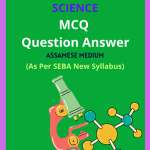Class 8 Science MCQ Chapter 2 Microorganisms: Friend or Foe Solutions in English Medium, Class 8 Science Multiple Choice Question Answer in English to each chapter is provided in the list so that you can easily browse throughout different chapters Class 8 Science MCQ Chapter 2 Microorganisms: Friend or Foe Notes and select need one.
Class 8 Science MCQ Chapter 2 Microorganisms: Friend or Foe
Also, you can read the SCERT book online in these sections Class 8 Science Objective Type Solutions by Expert Teachers as per SCERT (CBSE) Book guidelines. These solutions are part of SCERT All Subject Solutions. Here we have given Assam Class 8 Science MCQs Solutions in English for All Subject, You can practice these here.
Microorganisms: Friend or Foe
Chapter – 2
| MCQ |
1. Which of the following enzymes is secreted by bacteria that can digest cellulose?
(a) Amylase.
(b) Cellulase.
(c) Lipase.
(d) Protease.
Ans: (b) Cellulase.
2. Which of the following microorganism lives alone:
(a) Amoeba.
(b) All Bacteria.
(c) Fungi.
(d) All Cyanobacteria.
Ans: (a) Amoeba.
3. Which two words are synonyms?
(a) Microorganism and pathogen.
(b) Microorganism and microbe.
(c) Microbe and aerobe.
(d) Microbe and anaerobe.
Ans: (b) Microorganism and microbe.
4. Curd formations need:
(a) citric acid bacterium.
(b) acetic acid bacterium.
(c) lactic acid bacterium.
(d) all the above.
Ans: (c) lactic acid bacterium.
5. TMV causes disease in:
(a) tobacco plant.
(b) human infants.
(c) timber plants.
(d) none of the above.
Ans: (a) tobacco plant.
6. What are pond scum?
(a) algae.
(b) protozoa.
(c) fungi.
(d) bacteria.
Ans: (a) algae.
7. A plant disease called citrus canker is caused by a .
(a) Virus.
(b) Protozoa.
(c) Bacteria.
(d) Fungi.
Ans: (c) Bacteria.
8. Bacteriophage is a:
(a) fungi.
(b) protozoa.
(c) virus.
(d) bacteria.
Ans: (c) virus.
9. Which of the following statements describes bacteriophage correctly?
(a) It is a bacterium which causes diseases in plants.
(b) It is a type of virus which attacks bacteria.
(c) It is a bacterium which kills viruses.
(d) It can multiply inside both living and nonliving cells.
10. Which of the following disease causing pathogens is/are carried by mosquitoes?
(a) Dengue fever.
(b) Malaria.
(c) Cholera.
(d) Both (A) and (B).
Ans: (d) Both (A) and (B).
11. Which of the following terms is given to the microorganisms that cause diseases?
(a) Antigens.
(b) Antibodies.
(c) Pathogens.
(d) Vectors.
Ans: (c) Pathogens.
12. Malaria Is caused by:
(a) Protozoa.
(b) Virus.
(c) Algae.
(d) Bacteria.
Ans: (a) Protozoa.
13. Rhizobium bacteria-
(a) Help in nitrogen fixation.
(b) Help in digestion.
(c) Cause diseases.
(d) All of these.
Ans: (b) Help in digestion.
14. Scientist who discovered fermentation is:
(a) Louis pasteur.
(b) Alexander fleming.
(c) John mendel.
(d) Edward jenner.
Ans: (a) Louis pasteur.
15. Amoeba belongs to:
(a) Protozoa.
(b) Algae.
(c) Fungi.
(d) Virus.
Ans: (a) Protozoa.

Hi! my Name is Parimal Roy. I have completed my Bachelor’s degree in Philosophy (B.A.) from Silapathar General College. Currently, I am working as an HR Manager at Dev Library. It is a website that provides study materials for students from Class 3 to 12, including SCERT and NCERT notes. It also offers resources for BA, B.Com, B.Sc, and Computer Science, along with postgraduate notes. Besides study materials, the website has novels, eBooks, health and finance articles, biographies, quotes, and more.




